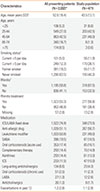1. Global Initiative for Asthma. Global strategy for asthma management and prevention (update) [Internet]. [place unknown]: Global Initiative for Asthma;2011. cited 2012 Jul 3. Available from:
http://www.ginasthma.org/.
2. Masoli M, Fabian D, Holt S, Beasley R. Global Initiative for Asthma (GINA) Program. The global burden of asthma: executive summary of the GINA Dissemination Committee report. Allergy. 2004; 59:469–478.
3. Park HS, Choi GS, Cho JS, Kim YY. Epidemiology and current status of allergic rhinitis, asthma, and associated allergic diseases in Korea: ARIA Asia-Pacific workshop report. Asian Pac J Allergy Immunol. 2009; 27:167–171.
4. Thomson NC. The role of environmental tobacco smoke in the origins and progression of asthma. Curr Allergy Asthma Rep. 2007; 7:303–309.
5. Clatworthy J, Price D, Ryan D, Haughney J, Horne R. The value of self-report assessment of adherence, rhinitis and smoking in relation to asthma control. Prim Care Respir J. 2009; 18:300–305.
6. Thomson NC, Chaudhuri R. Asthma in smokers: challenges and opportunities. Curr Opin Pulm Med. 2009; 15:39–45.
7. Kim TB, Park CS, Bae YJ, Cho YS, Moon HB. COREA Study Group. Factors associated with severity and exacerbation of asthma: a baseline analysis of the cohort for reality and evolution of adult asthma in Korea (COREA). Ann Allergy Asthma Immunol. 2009; 103:311–317.
8. Lee T, Lee YS, Bae YJ, Kim TB, Kim SO, Cho SH, Moon HB, Cho YS. COhort for Reality and Evolution of adult Asthma in Korea study group (COREA study group). Smoking, longer disease duration and absence of rhinosinusitis are related to fixed airway obstruction in Koreans with severe asthma: findings from the COREA study. Respir Res. 2011; 12:1.
9. Chalmers GW, Macleod KJ, Little SA, Thomson LJ, McSharry CP, Thomson NC. Influence of cigarette smoking on inhaled corticosteroid treatment in mild asthma. Thorax. 2002; 57:226–230.
10. Chaudhuri R, Livingston E, McMahon AD, Thomson L, Borland W, Thomson NC. Cigarette smoking impairs the therapeutic response to oral corticosteroids in chronic asthma. Am J Respir Crit Care Med. 2003; 168:1308–1311.
11. Kerstjens HA, Overbeek SE, Schouten JP, Brand PL, Postma DS. Dutch CNSLD Study Group. Airways hyperresponsiveness, bronchodilator response, allergy and smoking predict improvement in FEV1 during long-term inhaled corticosteroid treatment. Eur Respir J. 1993; 6:868–876.
12. Lazarus SC, Chinchilli VM, Rollings NJ, Boushey HA, Cherniack R, Craig TJ, Deykin A, DiMango E, Fish JE, Ford JG, Israel E, Kiley J, Kraft M, Lemanske RF Jr, Leone FT, Martin RJ, Pesola GR, Peters SP, Sorkness CA, Szefler SJ, Wechsler ME, Fahy JV. National Heart Lung and Blood Institute's Asthma Clinical Research Network. Smoking affects response to inhaled corticosteroids or leukotriene receptor antagonists in asthma. Am J Respir Crit Care Med. 2007; 175:783–790.
13. Chaudhuri R, Livingston E, McMahon AD, Lafferty J, Fraser I, Spears M, McSharry CP, Thomson NC. Effects of smoking cessation on lung function and airway inflammation in smokers with asthma. Am J Respir Crit Care Med. 2006; 174:127–133.
14. Fauler J, Frölich JC. Cigarette smoking stimulates cysteinyl leukotriene production in man. Eur J Clin Invest. 1997; 27:43–47.
16. Oh EG, Kim SH, Kim BH, Park MS, Kim SK, Kim YS. Health behaviour and quality of life in Korean adults with respiratory disease: National Health Survey, 2005. Int J Tuberc Lung Dis. 2010; 14:772–778.
17. Zainudin BM, Lai CK, Soriano JB, Jia-Horng W, De Guia TS. Asthma Insights and Reality in Asia-Pacific (AIRIAP) Steering Committee. Asthma control in adults in Asia-Pacific. Respirology. 2005; 10:579–586.
18. Rayens MK, Burkhart PV, Zhang M, Lee S, Moser DK, Mannino D, Hahn EJ. Reduction in asthma-related emergency department visits after implementation of a smoke-free law. J Allergy Clin Immunol. 2008; 122:537–541.e3.
19. Jang AS, Park SW, Kim DJ, Uh S, Kim YH, Whang HG, Lim GI, Park CS. Effects of smoking cessation on airflow obstruction and quality of life in asthmatic smokers. Allergy Asthma Immunol Res. 2010; 2:254–259.
20. Jang AS, Park JS, Lee JH, Park SW, Kim DJ, Uh ST, Kim YH, Park CS. The impact of smoking on clinical and therapeutic effects in asthmatics. J Korean Med Sci. 2009; 24:209–214.
21. O'Byrne PM, Lamm CJ, Busse WW, Tan WC, Pedersen S. START Investigators Group. The effects of inhaled budesonide on lung function in smokers and nonsmokers with mild persistent asthma. Chest. 2009; 136:1514–1520.
22. Cho SH, Park HW, Rosenberg DM. The current status of asthma in Korea. J Korean Med Sci. 2006; 21:181–187.
23. Price D, Bjermer L, Popov TA, Chisholm A. Integrating evidence for managing asthma in patients who smoke. Allergy Asthma Immunol Res. 2014; 6:114–120.









 PDF
PDF ePub
ePub Citation
Citation Print
Print



 XML Download
XML Download